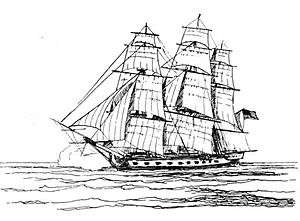Battle of Barbados
| Battle of Barbados | |||||||
|---|---|---|---|---|---|---|---|
| Part of the American Revolutionary War | |||||||
 USS Randolph | |||||||
| |||||||
| Belligerents | |||||||
|
|
| ||||||
| Commanders and leaders | |||||||
|
|
| ||||||
| Strength | |||||||
|
1 frigate 1 brig | 1 ship-of-the-line | ||||||
| Casualties and losses | |||||||
|
301 killed 4 captured 1 frigate sunk |
5 killed 12 wounded | ||||||
The Battle of Barbados was fought in March 1778 during the American Revolutionary War. While escorting a fleet of American ships in the West Indies, the frigate USS Randolph was attacked by the British ship-of-the-line HMS Yarmouth. The following action resulted in America's most costly naval defeat, in terms of human lives, until the sinking of USS Arizona in 1941.[1][2]
Background
Captain Nicholas Biddle commanded the thirty-six-gun USS Randolph, having received orders from John Rutledge to break the enemy blockade of Charleston, South Carolina where a large number of merchantmen were trapped. After breaking the blockade Biddle was to sail into the South Atlantic. Four other armed ships accompanied the Randolph in this mission: the General Moultrie, the Notre Dame, the Fair American and the Polly. However, after sailing out to meet the British off Charleston on February 14, the enemy was nowhere in sight, so the American fleet headed for the West Indies where Biddle would raid commerce. On February 16, the fleet burned a British ship that had been dis-masted by a privateer, and on March 4, the Polly captured a small schooner that was added to the fleet as a tender. Three days after that, at about 5:30 pm, on March 7, 1778, the Americans were sailing off the eastern coast of Barbados when lookouts spotted a large ship to the windward. Captain Biddle assumed the vessel to be a man-o-war so he directed most of his ships to continue on while he remained behind with the Randolph and the eighteen-gun ship General Moultrie to engage the oncoming vessel.[3]
Battle
The enemy ship turned out to be the sixty-four-gun HMS Yarmouth under the command of Captain Nicholas Vincent. After a few hours of maneuvering, at about 9:00 pm, the Americans raised their colors and opened fire on the Yarmouth with a broadside. The British, in turn, responded and opened fire. This bloody battle raged on for twenty minutes. Captain Biddle was wounded early in the battle but continued to fight. It is thought that the shots that wounded him came from the General Moultrie, which accidentally struck the Randolph.
The Americans seemed to be on the verge of victory when a spark entered the Randolph's powder magazine, causing a large explosion that completely destroyed the frigate in an instant. The USS Randolph then sank with a loss of 301 men and only four survivors. Captain Biddle died ten days later due to the wounds he sustained.
According to Captain Hall of the Notre Dame, Biddle and his men heavily damaged the Yarmouth in the first twelve to fifteen minutes, while the American ships were still mostly unharmed. The Yarmouth lost her bowsprit and her topmasts, a portion of which fell down and damaged the poop deck. Another portion of the topmasts fell into the top-gallant sails and then onto the cap. Five British sailors were killed and another twelve men received wounds.[4]
Aftermath
After sinking the Randolph, Captain Vincent attempted to pursue the other American ships, to no avail, as they dispersed in separate ways. Damage to the Yarmouth's sail also gave the Americans the advantage to slip away. The four surviving Americans were not captured five days later; HMS Yarmouth came across them on March 12 while she was chasing a ship west. The four survivors were found clinging to wreckage and had survived by sucking rain water out of a blanket. The death of Captain Biddle was considered a severe blow to the Continental Navy. Biddle was well respected and regarded as a professional sailor and a strong leader.[5]
References
- ↑ "Archived copy". Archived from the original on 2012-03-09. Retrieved 2011-12-27.
- ↑ Maclay, pg. 83–84
- ↑ Allen, pg. 296
- ↑ Allen. pg. 297
- ↑ Allen, pg. 298
This article incorporates text from the public domain Dictionary of American Naval Fighting Ships.
Bibliography
- Allen, Dardner W. (1913). A naval history of the American Revolution, Volume 1. Houghton Mifflin Company.
- Maclay, Edgar S. (1898). A History of the United States Navy, from 1775 to 1898. D. Appleton and Co.